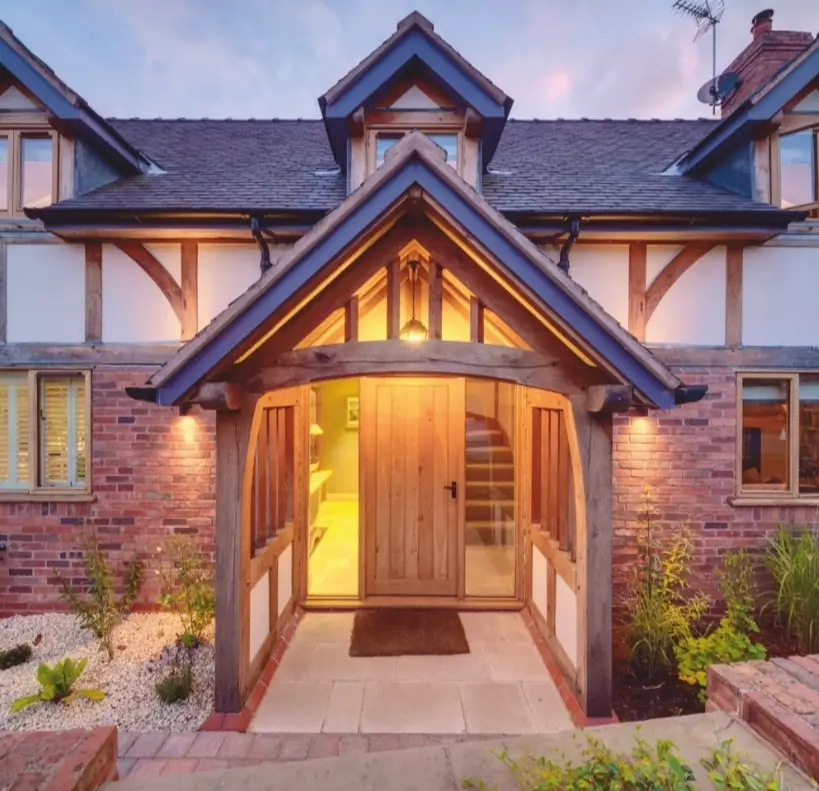Whether you’re renovating or building a new home from scratch, it’s important to choose an entrance that looks good, offer security and performs well. Here’s what you need to know before buying.
When it comes to choosing a front door for your home, there’s a fine balance to achieve between performance/security and aesthetics.
Whether you choose an off-the-shelf model or have a bespoke design made to order, there’s a lot to think about in terms of security, thermal performance and access requirements.
Selecting a design that compliments and enhances the appearance of your house is an important step, too.
Here, I lay out what you need to know, from the costs, to the do’s and don’ts of installing a door.
Style guide
The front door is one of the first things you see when you lay eyes on a property, so selecting a model that harmonizes with the design and character of your home is a smart way to boost overall kerb appeal.
Spend plenty of time researching the styles that may suit your property.
Traditional designs can be subdivided into a plethora of categories, from Edwardian and Victorian period models, to characterful stable designs.
If you’re building a contemporary new home, however, a sleek and bold solution with side glazing may be a better fit.
Oversized doors are particularly popular.
There’s also a range of retro options if you’re keen to incorporate a quirky design.
The first question to ask yourself about any entrance is how it fits into the existing building design (if you’re renovating) and whether that doorway/entrance could have a strong impact on the balance of the building.
Should the door be large, small, match the windows above it – or should it blend with the frontage?
Material used on the outside of the building like window frames, cladding, render, plus zinc, copper or stone details, all have an impact on the door you’ll choose.
Whether you’re building a new home or renovating, the front door is the perfect place to incorporate a design talking point.
If the entrance is in a small porch, the neutral colors can make it seem bigger and additional glazing can help add light.
If you have a grand entrance, then having a different color frame to the leaf (panel) helps it stand out.
Whatever style you choose, various off-the-shelf options are available for as little as $250 USD.
However, to infuse extra wow factor, you might consider going down the bespoke route.
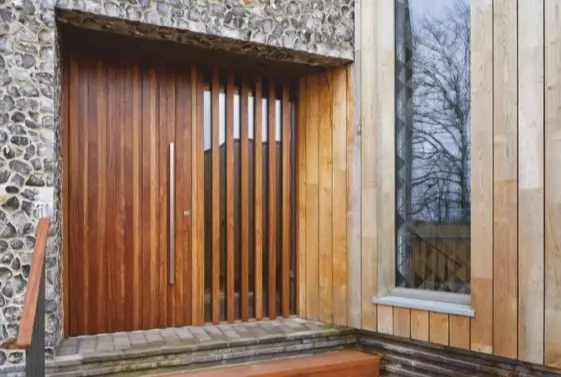
Material choices
Your choice of door construction will depend on your available budget, design aspirations and key performance objectives.
Timber is an extremely strong and durable material with excellent insulating properties.
"Wooden doors can be painted and stained in any color, the number of timber types to choose from,” says Matt Higgs, director/co-owner of Kloeber.
Prices start at around $2,000 USD at the higher end of the market.
For an off-the-shelf timber product, prices typically start between $250 and $500 USD.
For a sleek, contemporary new build, aluminum may be the best fit.
Not only can this metal be powder coated in any color, but also it offers excellent thermal performance thanks to the fact that the core of the door panel is packed with insulation.
Aluminum front doors generally sit at the higher end of the market in terms of cost, starting at $3,000 USD.
However, for the budget-conscious self-builder or renovator, PVCu is a strong contender.
Off-the-shelf options are available from $250+.
Available in a broad range of styles and colors, high quality versions can provide an attractive solution for your front entrance.
Like with any material, there are pros and cons to PVCu, with availability and price being the main benefit.
The downsides would be the movement that occurs with climatic change and sometimes clunky-looking hinges.
Expect to pay less than $1,250 for a d40 plastic front door.
Composite front doors provide a robust solution.
They are formed of a compressed foam or softwood core with an engineered glass fiber reinforced plastic (GRP) panel fitted to the internal and external sides of the leaf.
These doors can be cost-effective and perform well for security, insulation, and weathertightness.
Expect to pay between $1,500 and $1,800, but off-the-shelf models bought for around $600+.
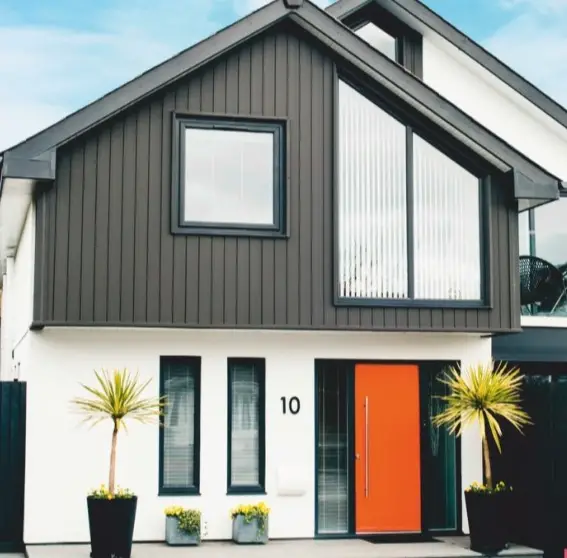
MAKING AN ENTRANCE
Incorporating a porch is one way to make your home's front entrance stand out.
The gorgeous oak frame example in the feature picture above provides both a design talking point and a practical covered area that's protected from the elements when you’re rummaging to find your key.
Welsh Oak Frame completed this project.
Access considerations
Access is a key aspect to bear in mind at the design stage of the project, if you're self-building.
All doors on new builds must comply with building regulations in terms of accessibility.
For instance, thresholds must not be more than 15 mm above floor level and should be flush inside.
There should also be a clear passage of 775 mm in the width of the aperture.
Doors in existing buildings don't have to comply with the same threshold standards.
Most entrances on existing houses have a small step up, that's hard to rectify.
Thermal performance
Thermal performance is also a key consideration when seeking to meet building regulations standards.
As outlined above, some materials will perform better than others in this area will.
Replacement doors and new doors in extensions should have a U value (measure of heat loss, where lower numbers are better) of 1.8W/m2K, and the new builds between 1.1W/m2K and 2.2W/m2K.
If you're building to create a low-energy home, perhaps building to Passivhaus standards, you're looking at an even higher standard of performance for your front door, where U values of 0.8W/m2K (or better) are required.
Hörmann’s ThermoCarbon door, for instance, achieves U values as low as 0.47 W/m2K.
Remember, the thermal performance of your entrance will only ever be as good as it's installation.
The frame will need to be installed and sealed effectively so you aren't leaking heat through the building fabric.
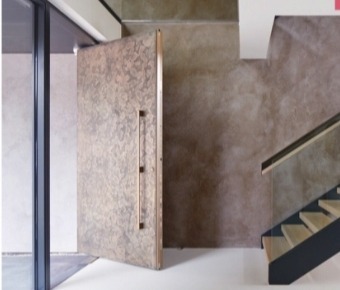
Security
While most people think a burglar would never be bold enough to enter your home through the front door, it's one of the most common entry points during break-ins.
Research by Monkey Supermarket in 2018 revealed that 74% of burglars came through the front door, so it is important to choose a model that meets high security standards.
The main idea is to delay someone from getting into the house for as long as possible.
The longer they spend trying to break in, it's more likely they'll be caught in the act.
For peace of mind, choose a model that comes with proper security accreditation - sometimes an anti-crime initiative led by the police that aims to improve the quality of our homes and their surroundings via good design.
Consider the quality of the locks, too, incorporating a three-point multi-point deadlocking system as a minimum - some doors even come with a five-point set up.
Another aspect to look into is the strength of the door when withstanding hammering or kicking, as well as the strength of the key cylinder with anti-saw and anti-drill protection.
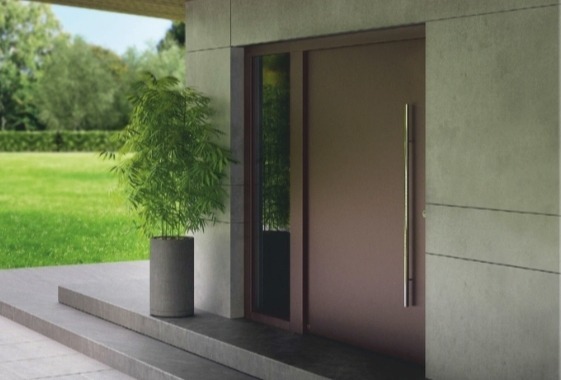
Smart features
In terms of design innovations, security and automation are two of the main areas of focus for front doors.
A simple smart tech solution could be to install a security camera at the front entrance.
For example, some of the security cameras featured in this article and this article can be used indoors or outdoors and will send an alert directly to your phone when it's motion sensor is triggered.
Another option is to fit a status sensor to your front door to see if it has been left open, alerting you via a text to your smartphone.
For some homeowners, a smart lock is a must-have front door accessory that will enable you to monitor who is coming in and out of the house while you're not there.
For example, the August Smart Lock allows you to use your smartphone as the intelligent key to your home.
As well as being able to lock and unlock your front door via your phone, you can create virtual keys for guests and keep track of who comes and goes to and from the house.
This handy gadget can also be integrated with voice-activated tech such as Google assistant and Amazon Alexa.
If you work from home, a smart video entry system with an integrated doorbell camera could be another useful addition.
Installation know-how
As the installation of a new (and replacement) front door needs to comply with building regulations standards for security and thermal performance, it's often a job that's best left to the professionals.
You need the proper certification as proof the installation complies with building regulations.
One way to get this certification is to use an accredited installer who will be registered with the local council (which is a legal requirement).
If your supplier offers its own installation service, it makes sense to go with this option.
That way, if there's a problem with the door once it arrives on site, responsibility lies with the company.
Firms that don't offer an installation service will usually be able to put you in touch with a reputable professional Carpenter to fit the door, too.
If you are having a professional fit your new door, the first step is to fit the new frames (providing you're not installing the new entrance into an existing frame).
This element is usually strap fixed to ensure it is perfectly level.
Next, the door panels are hung and the system is adjusted and tested.
The frames are then sealed against the opening.
There are numerous methods for this, including expanding foam tape, expanding foam and silicone.
The choice between these options usually come down to the type of opening and external finished.
Finally, a whole entrance is cleaned and presented to the homeowner for sign-off.
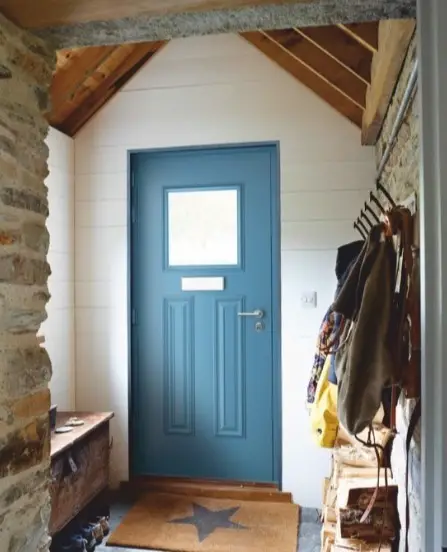
Fitting your own front door
If you plan to save on labor costs by installing the door yourself, check the product you purchased is pre-hung.
This means that the doors are hung in the factory with hardware fitted and then taken apart again for transport and delivery.
It means no cutting for hinges is required on site, which is a skilled job.
If you intend to fit the door yourself, always ask your supplier for a detailed list of fitting instructions that matches their products.
Installation of new and replacement front doors need to comply with building regulations for fire safety, thermal performance, sound insulation and security so you need to notify your Council of your plans to fit the door yourself.
Typically, the most straightforward route is to purchase a door set, which comprises the door panel already hung within the frame.
If you're fitting the door into an existing frame, you may find that the frame is not of standard measurements, so a bespoke replacement will need to be fabricated.
Subject to the product specifications, the first step is to measure the size of the door opening, with a 2mm gap around the panel within its frame.
The door will need to be trimmed to size if necessary, using an electric plane.
Next, chisel out recesses for the hinges and screw the hinges to the door before fitting the hinges to the frame.
Finally, skip the locks and ironmongery.
Relates guides:
This page contains affiliate links, which means I may earn a small commission if you click through and make a purchase. You will not pay any extra. More details here.

